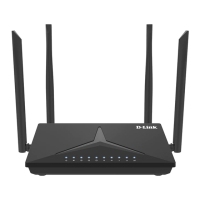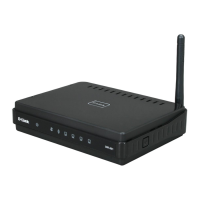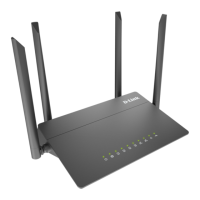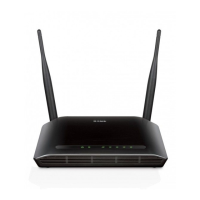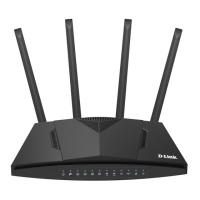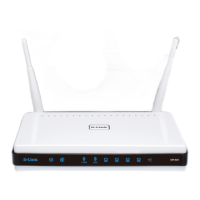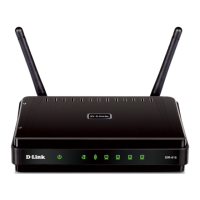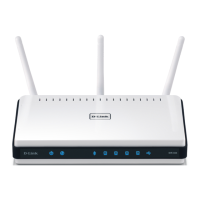Do you have a question about the D-Link M30 and is the answer not in the manual?
Overview of the D-Link AX3000 Dual-Band Wi-Fi 6 Router, its features and purpose.
Details on the revisions and versions of the user manual.
Legal notices regarding trademarks and copyright ownership.
Information on the device's power consumption in standby and switched-off states.
Lists all items included in the router package for setup and initial use.
Details hardware and software needed for router setup and management.
Pre-installation checks and considerations for connecting the router.
Guidelines for optimal wireless signal placement and performance.
Overview of methods for configuring the router, including app and wizard.
Explains the meaning of different LED colors and patterns for status indication.
Identifies and describes the function of each port and button on the router's rear panel.
Steps to log in to the router's web-based management interface.
Description of the router's home screen displaying network status.
Configuring various internet connection types like IPv4, IPv6, and VLAN.
Details on viewing and configuring wireless and local network settings.
Managing connected devices, viewing their details, and setting parental controls.
Managing mesh network topology, adding extenders, and viewing device status.
Step-by-step guide to configure the router using the setup wizard.
Setting up various IPv4 connection types like Static IP, DHCP, PPPoE, PPTP, L2TP, DS-Lite.
Configuring IPv6 connection types including Auto Detection, Static, SLAAC, PPPoE, 6rd, and Local Only.
Enabling and configuring Wi-Fi Mesh and Smart Connect features for network optimization.
Setting up Wi-Fi network name (SSID) and password for wireless connectivity.
Detailed configuration options for 2.4GHz and 5GHz bands, including security and channel.
Optimizing Wi-Fi performance and managing bandwidth with AI features.
Creating a separate wireless network for guests to access the internet.
Configuring LAN IP, Subnet Mask, DHCP server, and port settings.
Selecting the operating mode for the router (Router, Extender, Bridge).
Setting up schedules and website filters to restrict internet access for specific devices.
Configuring firewall rules, DMZ, SPI, and IPv6 security features.
Setting up port forwarding rules and virtual server for specific applications.
Defining custom static routes for IPv4 and IPv6 traffic management.
Configuring dynamic DNS service for remote access to the router.
Setting up a Virtual Private Network (VPN) for secure remote connections.
Configuring the router's time, date, and setting up schedules for functions.
Accessing system logs and configuring e-mail notifications for events.
Managing administrator password, HTTPS server, and LED control.
Backing up, restoring, and resetting router configuration settings.
Creating, managing, and deleting user accounts for router access.
Updating the router's firmware automatically or manually.
Viewing network traffic statistics for Internet, LAN, and Wi-Fi interfaces.
Overview of AI features like Wi-Fi Optimizer, Traffic Optimizer, and Parental Control.
Instructions for setting up voice control with Amazon Alexa and Google Assistant.
Explanation of Quick VPN technology and important setup information.
Step-by-step guide to configure VPN on iOS devices.
Step-by-step guide to configure VPN on Mac OS X systems.
Step-by-step guide to configure VPN on Windows 10 systems.
Step-by-step guide to configure VPN on Android devices.
Using the WPS button for quick and easy wireless device connection.
Steps to connect a Windows 10 computer to a wireless network.
Solutions for issues accessing the router's web-based management interface.
Procedure to reset the router to factory defaults if the password is forgotten.
Explains the fundamental concepts of wireless networking and WLAN/WPAN.
Practical advice for optimizing wireless network performance and security.
Details on different wireless security protocols for data protection.
Information on device interfaces, LED indicators, antennas, and wireless standards.
Details on security protocols, firewall, mesh, QoS, size, weight, and power.
Information on device management software and voice assistant compatibility.
FCC regulations regarding interference, usage, and exposure limits.
Compliance information for Innovation, Science and Economic Development Canada.
EU conformity declarations for the product and its firmware.
Overview of the D-Link AX3000 Dual-Band Wi-Fi 6 Router, its features and purpose.
Details on the revisions and versions of the user manual.
Legal notices regarding trademarks and copyright ownership.
Information on the device's power consumption in standby and switched-off states.
Lists all items included in the router package for setup and initial use.
Details hardware and software needed for router setup and management.
Pre-installation checks and considerations for connecting the router.
Guidelines for optimal wireless signal placement and performance.
Overview of methods for configuring the router, including app and wizard.
Explains the meaning of different LED colors and patterns for status indication.
Identifies and describes the function of each port and button on the router's rear panel.
Steps to log in to the router's web-based management interface.
Description of the router's home screen displaying network status.
Configuring various internet connection types like IPv4, IPv6, and VLAN.
Details on viewing and configuring wireless and local network settings.
Managing connected devices, viewing their details, and setting parental controls.
Managing mesh network topology, adding extenders, and viewing device status.
Step-by-step guide to configure the router using the setup wizard.
Setting up various IPv4 connection types like Static IP, DHCP, PPPoE, PPTP, L2TP, DS-Lite.
Configuring IPv6 connection types including Auto Detection, Static, SLAAC, PPPoE, 6rd, and Local Only.
Enabling and configuring Wi-Fi Mesh and Smart Connect features for network optimization.
Setting up Wi-Fi network name (SSID) and password for wireless connectivity.
Detailed configuration options for 2.4GHz and 5GHz bands, including security and channel.
Optimizing Wi-Fi performance and managing bandwidth with AI features.
Creating a separate wireless network for guests to access the internet.
Configuring LAN IP, Subnet Mask, DHCP server, and port settings.
Selecting the operating mode for the router (Router, Extender, Bridge).
Setting up schedules and website filters to restrict internet access for specific devices.
Configuring firewall rules, DMZ, SPI, and IPv6 security features.
Setting up port forwarding rules and virtual server for specific applications.
Defining custom static routes for IPv4 and IPv6 traffic management.
Configuring dynamic DNS service for remote access to the router.
Setting up a Virtual Private Network (VPN) for secure remote connections.
Configuring the router's time, date, and setting up schedules for functions.
Accessing system logs and configuring e-mail notifications for events.
Managing administrator password, HTTPS server, and LED control.
Backing up, restoring, and resetting router configuration settings.
Creating, managing, and deleting user accounts for router access.
Updating the router's firmware automatically or manually.
Viewing network traffic statistics for Internet, LAN, and Wi-Fi interfaces.
Overview of AI features like Wi-Fi Optimizer, Traffic Optimizer, and Parental Control.
Instructions for setting up voice control with Amazon Alexa and Google Assistant.
Explanation of Quick VPN technology and important setup information.
Step-by-step guide to configure VPN on iOS devices.
Step-by-step guide to configure VPN on Mac OS X systems.
Step-by-step guide to configure VPN on Windows 10 systems.
Step-by-step guide to configure VPN on Android devices.
Using the WPS button for quick and easy wireless device connection.
Steps to connect a Windows 10 computer to a wireless network.
Solutions for issues accessing the router's web-based management interface.
Procedure to reset the router to factory defaults if the password is forgotten.
Explains the fundamental concepts of wireless networking and WLAN/WPAN.
Practical advice for optimizing wireless network performance and security.
Details on different wireless security protocols for data protection.
Information on device interfaces, LED indicators, antennas, and wireless standards.
Details on security protocols, firewall, mesh, QoS, size, weight, and power.
Information on device management software and voice assistant compatibility.
FCC regulations regarding interference, usage, and exposure limits.
Compliance information for Innovation, Science and Economic Development Canada.
EU conformity declarations for the product and its firmware.
| Brand | D-Link |
|---|---|
| Model | M30 |
| Category | Wireless Router |
| Language | English |
